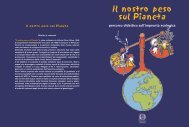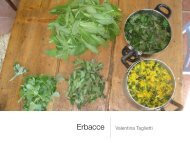Myanmar Protected Areas: Context, Current Status ... - Istituto Oikos
Myanmar Protected Areas: Context, Current Status ... - Istituto Oikos
Myanmar Protected Areas: Context, Current Status ... - Istituto Oikos
You also want an ePaper? Increase the reach of your titles
YUMPU automatically turns print PDFs into web optimized ePapers that Google loves.
Step 4. Change detection analysis<br />
In order to detect and to evaluate the land cover changes (decreasing and recovering process over time)<br />
the multi-temporal Landsat MSS and ETM+ images, acquired respectively on 23 November 1978 and 17<br />
November 2001 at full vegetation cover in the cool season, were initially pre-processed and adopted for<br />
a NDVI (Normalised Difference Vegetation Index) Image Differencing algorithm for change detection.<br />
Changes were classified into 5 categories such as “increase”, “moderate increase”, “no-change”, “moderate<br />
decrease” and “decrease” of NDVI change. A final map illustrating the types of change found in the study<br />
area was produced.<br />
Land cover change in Rakhine Yoma Elephant Range WR<br />
In-depth Study of Rakhine Yoma Elephant Range Wildlife Reserve<br />
4.2 Results<br />
Description of land cover classes<br />
A brief description of each land cover classes is presented, including mention of the causes of<br />
degradation.<br />
Mangrove Forest<br />
This class can be commonly encountered around the coastal area, principally along the estuaries. Main<br />
species are trees such as Avicennia officinalis and Rhizophora spp. Largely diffused by human activities is<br />
the palm Nipa fruticans, used for its fibres. Even if their extension is limited as total surface (only 2% of<br />
the study area), mangrove forests cover a big portion of the seaside. The importance of this ecosystem<br />
for the coastal region is very high in terms of biodiversity, coastal stabilisation, primary production<br />
and provision of nursery habitat for marine fish. The main threats to this habitat are the permanent<br />
conversion to agriculture or fish nurseries, and the degradation due to over-collection of fuel wood and<br />
poles.<br />
Western Coastal and Valley Agricultural <strong>Areas</strong><br />
This class comprises three different kinds of vegetation: the large agricultural fields situated on the<br />
coastal region; the small farms in the narrow valleys of the eastern side of the Rakhine Yoma; the seminatural<br />
dune and beach forests, often substituted with artificial plantation of palm species (such as<br />
coconut). The main crops are: dry paddy rice; different kinds of nuts and beans; chilli; tobacco. The<br />
surface of this class is around the 4% of the total.<br />
Western Mixed Deciduous Forest<br />
This forest type is encountered in the lowest western slopes of the Rakhine Yoma, where the evergreen<br />
species are reduced in abundance and mostly only deciduous trees are present: Xylia dolabriformis<br />
(Pyinkado or Iron Wood), Lannea grandis (Nabe), and Lagerstromea speciosa (Pyinma). Due to their close<br />
location to the most inhabited areas of the coastal region, this class is highly threatened by human<br />
pressure for timber, fuelwood and housing material. Moreover, as a result of traditional practices of weed<br />
and vermin control in the bordering agricultural areas, these forests are usually disturbed by fires. As a<br />
result, generally the fertility of this class seems to be severely degraded. Some artificial plantations have<br />
been found of Hevea brasiliensis (Rubber tree), Tectona grandis (Kyun or Teak), and Xylia dolabriformis,<br />
established mostly more than 10 years ago. The surface of this class is limited, covering only around the<br />
3% of the study area.<br />
Closed Semi-Evergreen Forest<br />
An intermediate step between the lowland mixed deciduous woodland and the evergreen forest present<br />
at the higher altitude, in this class deciduous and evergreen species are intimately mixed together. The<br />
most common species are Xylia dolabriformis and Dipterocarpus spp. (Kanyin), which are particularly<br />
characteristic of this ecosystem and can both form almost pure patches. Other trees occurring are Lannea<br />
grandis, Lagerstromea speciosa, as well as other evergreen species. Bamboos, like Bambusa polymorpha<br />
(Kyathaung Wa), and rattans (Calamus sp) are also found. The overall status of these forests seems to<br />
be better than the previous Western Mixed Deciduous Forest, although they cover only 4% and are<br />
increasingly threatened by human activities such as wood collection and fire disturbances.<br />
138 139






